American Military Patches, Other Insignia and Decorations of World War Two by Dr. Howard G. Lanham c.2011
Evolution of U.S. Army Infantry Insignia
1827 Infantryman wearing Silver and White Uniform Accents of the Bimetallic Era
By H. Charles McBarron
|
| 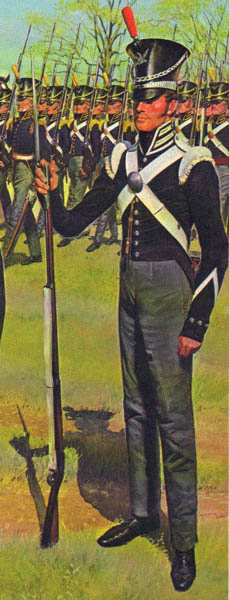
|
Infantrymen can be forgiven if they suspect that they are the only true soldiers. Throughout the centuries they have paid dearly for their distinctions and their honor. The word soldiers is said to come from "Solidus." The Solidus was a Byzantine coin that was used to pay the salaries of the professional mercenary soldiers hired to defend the Byzantine Empire. The word infantry is said to come from the Spanish word "Infantes." The Spanish, flush with gold from the new world, were the first to organize regimented and standardized military units rather than follow the common medieval practice of fielding what amounted to a "pick up team" of armed men who were followers of a nobleman, mustered at a sovereign's call or the more professional hired mercenaries if they could be afforded. However, it was not uncommon for them to pack up and go home at inopportune times or even defect to the enemy. Likewise their arms and armor were not standardized and often obsolete. The number of men in any given band at the point of muster might be too large or too small or they might arrive too early or too late leading to all manner of logistical nightmares. In the age of gunpowder soldiers needed both extensive training and discipline and the older medieval model was just not working. The nominal commanders of these new nascent Spanish regiments were the royal princes known as Los Infantes. The Spanish model was widely copied by other nations and the English word for foot soldiers so organized became infantry.
American colonists brought European military practices with them to the new world and were often led by men who were veterans of European wars. Not only were the Native Americans a threat but also the other rival colonial powers, whose armed ships might be just over the horizon. By the time of the American Revolution the male population of the various colonies acknowledged a standing oblation to perform militia service. On June 14, 1775 the Continental Congress organized the first of many units of the Continental Army and the next day appointed George Washington as the commander of the Continental Army. The American forces that faced the British were composed of two categories of troops. An effort was made to train the Continentals up to European standards and to retain them in long term service. Serving along side of them were militiamen whose military effectiveness was highly variable and whose term of enlistment was limited. That this force was able to survive against the British Army is short of miraculous but it might be said that the British managed to lose the war as much as the Americans and their French allies won it. Out of this struggle the U.S. Army was born and many of its traditions were developed.
Silver Colored Infantry Button
An Example of Utilitarian Insignia of the Bimetallic Era

|
|
Many of the leaders of the new republic had an aversion to a standing army and professional soldiers. During the Revolution unpaid and poorly fed troops had mutinied and some of Washington's officers had seriously suggested a military coup, given what was seen as the failure of Congress to act effectively. Historical lessons are often poorly learned and even today the nation is facing a situation in which military salaries might be held hostage to political brinksmanship. During the early years of its existence the U.S. Army was among the smallest in the world and on the eve of the American Civil War the standing Army was only 16,000 men. Jefferson believed that the very existence of a military encouraged its use and he actively reduced the size of both land and naval forces to bare bones. The legacy of his program was the great difficulty the U.S. had in fighting the War of 1812 during which the British were able to seize Washington and move at will along the eastern seaboard. The U.S. did better during the Mexican War but this was more a function of its inspired leadership and the inadequacies of the Mexican Army.
American uniforms were always more austere than their European counterparts and this was felt to be appropriate for the military of a republic. Aside from plates worn on early 19th Century shakos and cockades there were very few uniform features that could be characterized as non-utilitarian insignia. Prior to 1851 U.S. Army insignia and uniform features; such as buckles, buttons, epaulettes and even sword hilts, followed that is referred to as the bimetallic system. Basically this was that infantry units had white or silver colored uniform accents while other branches had gold or brass colored uniform accents. The bimetallic system disappeared with the revolutionary uniform regulations issued in 1851. The 1851 Regulations set up a system of branch insignia and branch colors many of which are still features of modern U.S. Army uniforms. There is only one counter-intuitive legacy of the bimetallic system still reflected in U.S. Army insignia (which I have fully explained elsewhere): the rank insignia of majors and second lieutenant are gold colored, a more noble color than the silver of higher ranking lieutenant colonels and first lieutenants.
Infantryman wearing the Hunting Horn Insignia
Civil War Period
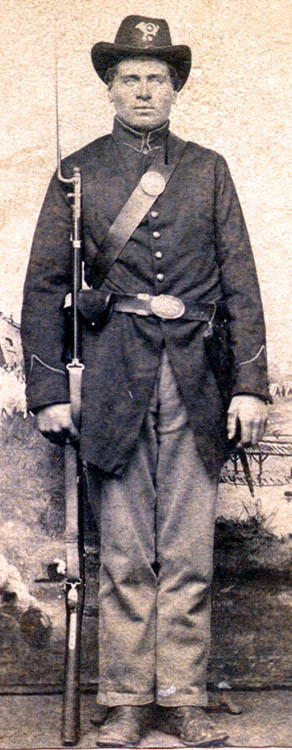
|
|
Enlisted Kepi 23rd Infantry
Company G
|
| 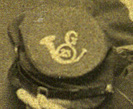
|
The original insignia used for infantry by the U.S. Army was not the familiar crossed rifles but the hunting horn. This was borrowed from the European armies, where it was used as an insignia for light infantry or rifle units. Those troops were often recruited from huntsmen and the horn was symbolic of the hunt. These first appeared as an individual U.S. Army insignia on the infantry cap (shako) of 1832. These were of an earlier style with the horn dangling from a tassel that was likely inspired by British light infantry units and identical to the one used by the British Oxfordshire and Buckinghamshire Light Infantry Regiment. The same design was used as an officer's skirt-tail ornament on the back of the tailed coats worn prior to the introduction of the frock coat. The more familiar style of the infantry horn, used extensively during the Civil War, first appeared on officer's forage cap bands in 1839.
During the Civil War branch insignia was worn on headgear by the Union Army. It appeared on the front of the dress hat and either on the front or the top of forage caps (kepis). The insignia indicated the regimental number but not the state affiliation. For example, a soldier of the 20th Maine or 20th New York would wear the same insignia. There was a wide variation in the insignia worn by individual soldiers on their headgear, ranging from none at all to all possible ones: infantry horn, corps badge, state abbreviation, regimental number and company letter. The American army has always been an army of individuals and regulations were not strictly enforced by these citizen soldiers.
Officer's Infantry Horn for 10th Regiment
This type was intended for the front of the Forage Cap.

|
|
|
Officer's Infantry Horn for 46th Regiment
This type was intended for the front of the Dress Hat.

|
|
An Infantry Officer's Hat Insignia
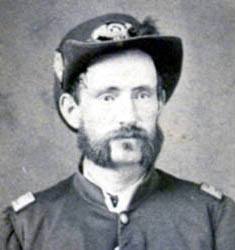
|
|
Regulation Enlisted Infantry Insignia
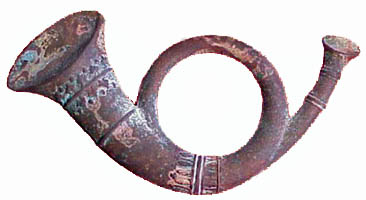
|
|
False Embroidered Infantry Horn
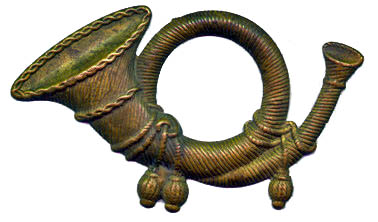
|
|
Enlisted Man holding Dress Hat

|
|
Enlisted Infantry Cap Insignia 1872-1875

|
|
At the close of the Civil War the volunteers were discharged. The Regular Army was involved in garrisoning the South during reconstruction and in fighting the Indian Wars. In 1869 Congress cut the infantry branch back to 25 regiments. The size of the army once again was allowed to fall and on the eve of the Spanish American War there only 26,000 enlisted men in service who were often commanded by aging Civil War veterans. The infantry horn insignia worn during the Civil War gave way to a somewhat smaller version in 1872 and in 1875 was replaced by a totally new and more logical insignia, crossed flintlock muskets. In 1881 a dress helmet was adopted that had a large eagle with crossed muskets and a shield on its chest. In 1895 officers began wearing branch insignia on their collars. The 1902 regulations also authorized crossed muskets for enlisted men's collars and in 1905 the insignia was redesigned replacing the muskets with model 1903 Springfield rifles. In 1910 enlisted collar disks made their debut.
13th Infantry Officer's Collar Insignia 1895-1905
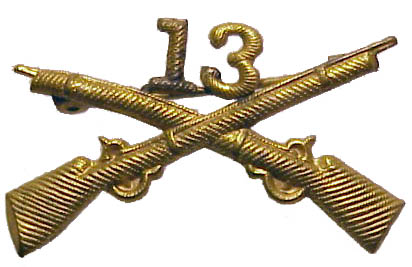
|
|
Enlisted Infantry Cap Insignia 1875-1896

|
|
7th Infantry Regiment Company M Enlisted Infantry Cap Insignia 1896-1905

|
|
13th Pennsylvania National Guard Infantry Regiment Company C Enlisted Infantry Cap Insignia 1896-1905

|
|
20th Infantry Officer's Collar Insignia 1895-1905

|
|
Infantry Enlisted Man's Dress Helmet Plate 1881-1902

|
|
16th Infantry Regiment Enlisted Man's Hat Insignia
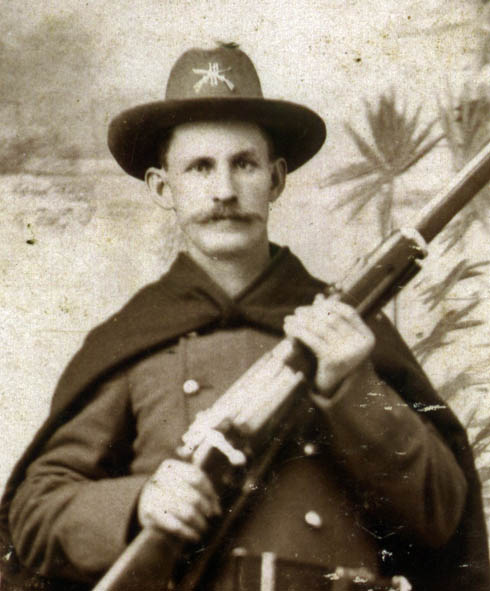
|
|
The period after the Spanish American War of 1898 was characterized by efforts at reform, reorganization and modernization. When United States entered World War One in 1917 its Army functioned with a never before realized degree of efficiency and against a modern, experienced German force. The principle world powers had fought themselves to exhaustion and the arrival of large number of fresh American troops tipped the scales in favor of the allies and the Central Power governments as well as Russia entered a period of instability, social unrest and in Russia's case revolution. It is difficult to decide between the First and the Second World War as to which produced the greater effect on world history, but I would argue for the First. Infantry insignia of the period was rather uniform and all had a dull bronze finish that appears not dissimilar to the modern subdued metallic branch insignia first worn during the Vietnam area. Officers' insignia were privately purchased and they had the option of adding the number of their regiment for a modest extra fee. During the war the Army replaced enlisted men's service branch hat insignia with a large disk having the U.S. eagle that was the same for all branches and after that time branch insignia (with some sporadic exceptions, such as the sides of some overseas caps or the cuff of officer's mess dress coats) were exclusively worn on collars or lapels.
Infantry Officer's Collar Insignia
World War One
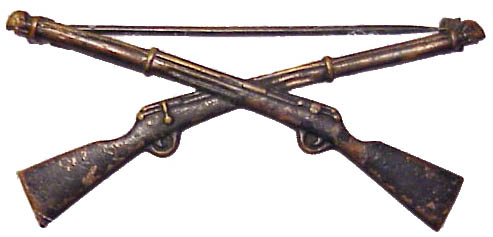
|
|
12th Infantry Regiment Officer's Collar Insignia
World War One
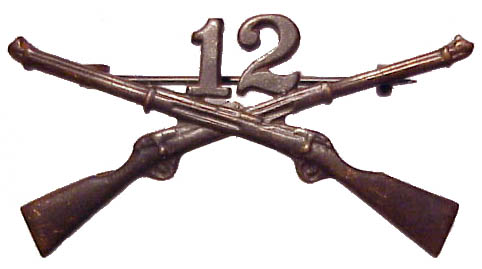
|
|
Infantry Enlisted Collar Disk
1910-1924

|
|
Infantry Company K
Enlisted Collar Disk 1917-1924
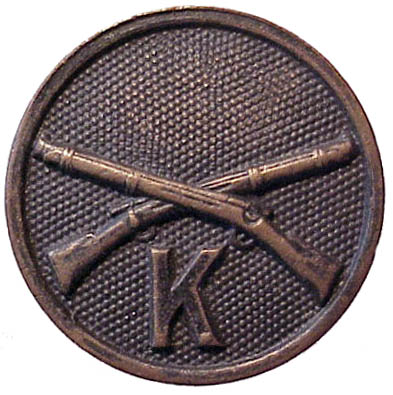
|
|
Infantry Machine Gun Battalion Company A
Enlisted Collar Disk 1917-1921
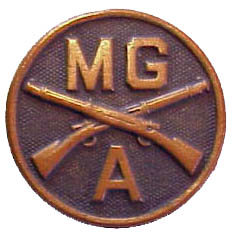
|
|
Infantry Supply Company
Enlisted Collar Disk 1915-1924
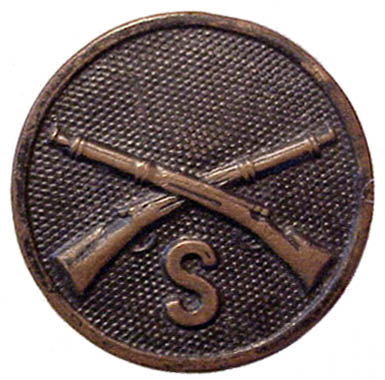
|
|
Company K 363rd Infantry Regiment
Enlisted Collar Disk 1917-1918

|
|
In 1920 the U.S. Congress in its nearly infinite wisdom had the inspiration to abolish the fledgling tank corps as an independent service branch and merge its elements into the infantry branch. This had the effect of putting armored innovations, both technical and tactical, into a deep freeze, at least at the highest leadership levels. Twenty years later as German armored forces smashed through Europe the U.S. Army woke up to the fact that it had a lot of catching up to do. However, that is not to say that the Army failed to modernized in other areas and on the eve of the Second World War it was fairly well prepared for the events that would follow. In 1924 Army uniform insignia were changed to a gilt or brass color and the dull bronze of World War One was discontinued. In 1926 the standing collar coat was replaced by lapel collars and insignia moved to the lapels of the coat and given smaller dimensions. Tanks units as part of the infantry branch were initially given a special insignia having crossed rifles with the letter T in a circle at the intersection. In 1922 this was replaced with pair of crossed rifles with a side view of a World War One tank. In 1923 Arthur E. Dubois redesigned the infantry insignia to be the Model 1795 musket with the idea that the prior Model 1903 Springfield design was destined to become obsolete. Although they were muskets the new insignia was still commonly called crossed rifles, no doubt something that would have irked DuBois, a heraldic expert with a penchant for correct terminology. Infantry collar disks were originally manufactured as a single piece but in the years prior to World War Two a new type made of three pieces and a retaining nut was introduced. This could be disassembled for shining and has been classified by collectors as Type III.
Pre-1923 12th Infantry Regiment Officer's Collar Insignia
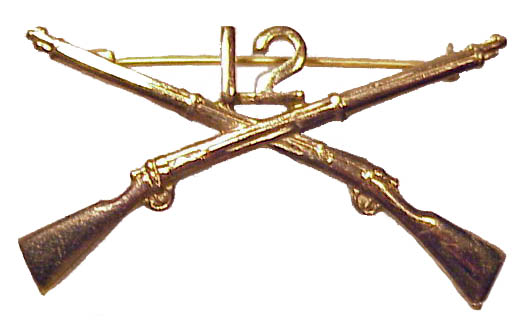
|
|
Post-1923 Infantry Officer's Lapel Insignia

|
|
Infantry Tank Officer's Lapel Insignia
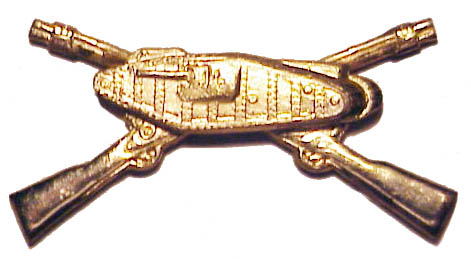
|
|
Officers had the option of displaying the regimental number on their crossed rifles. In some cases the number was brazed directly on the insignia and in others there was a bar struck as part of the insignia to which the numbers were affixed. Infantry branch insignia with regimental numbers were popular both before and after the war and the basic style of the muskets changed little. Often knowing the history of the regiment or of the original owner is necessary to date the piece. During the years 1939-1940 there were major changes in the organizations of the divisions of the U.S. Army. This was referred to as triangularization. Previously infantry divisions had four regiments but under triangularization the number was reduced to three and efforts were made to increase the firepower of soldiers using automatic and semiautomatic weapons. Thus, the loss of manpower was to be compensated for by an increase in firepower. Triangularization was unpopular with those officers whose regiments were stripped out of divisions, the World War One service of which had been a source of such pride. In 1940 Congress approved calling up reserves, federalizing the National Guard and instituting a peacetime draft. The size and funding for the Army was drastically increased even as public opinion was against American involvement in foreign wars.
Post-1923 3rd Infantry Regiment Company L Officer's Insignia
Made by A. H. Dondero with screw post back
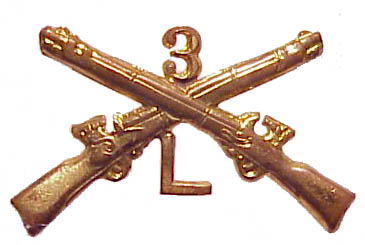
|
|
Post-1923 319th Infantry Officer's Insignia
Also a Dondero The letters are attached to a curved bar on the back.
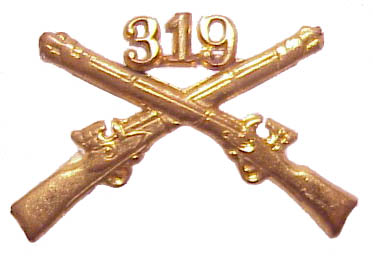
|
|
Post-1923 12th Infantry Regiment Officer's Insignia
It attaches by small screw posts and retaining nuts.
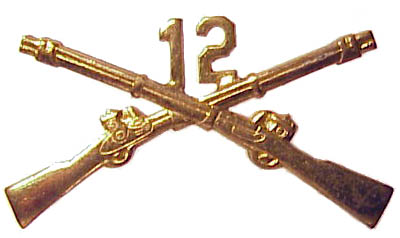
|
|
Post-1923 107th Infantry Regiment Officer's Insignia
This was a prewar New York National Guard unit.

|
|
Post-1923 402nd Infantry Regiment Officer's Insignia
This unit was disestablished in 1942.

|
|
Post-1923 421st Infantry Regiment (Heavy Tank) Officer's Insignia
This unit was disestablished prior to WWII.
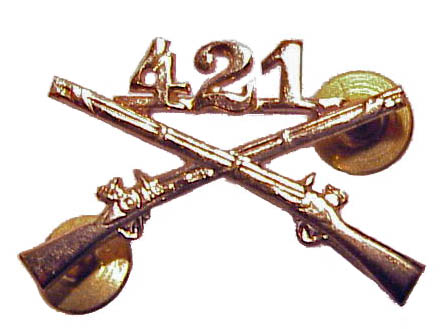
|
|
Infantry Company F
Enlisted Collar Disk 1924-1937
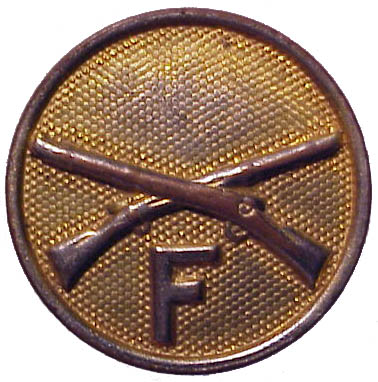
|
|
Infantry Howitzer Company
Enlisted Collar Disk 1926-1937
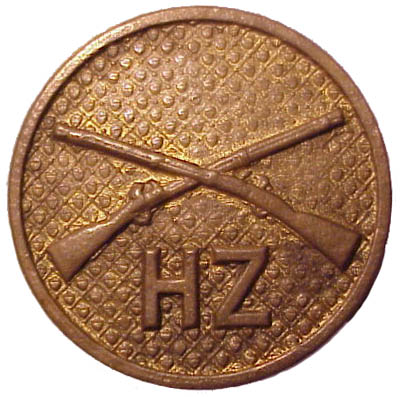
|
|
Infantry Company H
Enlisted Collar Disk 1937-1945
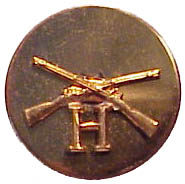
|
|
Infantry Headquarters Company
Enlisted Collar Disk 1937-1945
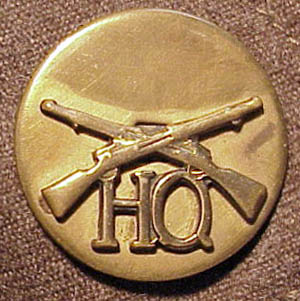
|
|
Infantry Tank Enlisted Collar Disk
1937-1942
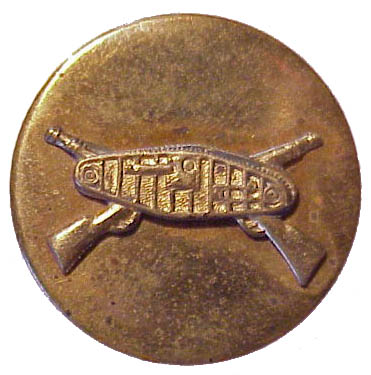
|
|
In 1941 the Japanese attacked Pearl Harbor and the nation was once again at war. There was a massive mobilization with ten and one-half million soldiers serving in the U.S. Army. These men and women found themselves circling the globe in what was truly a world war. The nation that emerged at the end of the war was not the nation that entered the war and the historical developments set in motion by this war still have some momentum even as the number of survivors of the conflict dwindle in numbers. While there was an effort to provide insignia that had camouflage value during World War One, it was decided that the small brass insignia on the service uniform coat were not that visible but in practice most front line soldiers wore field uniforms that lacked brass insignia. World War One insignia were attached by screw posts and retaining nuts or by pins on the back. During World War Two clutch fasteners became very common although the older means were still in use as well. World War Two officer's insignia are slightly smaller than their World War One counterparts, with the exception of those World War One ones that were intended to be worn of shirt collars. During the war there was less of an effort to display unit numbers or letters on insignia and most infantrymen wore plain crossed muskets.
Officer with 184th Infantry Regiment Cross Rifles
Early 1940s
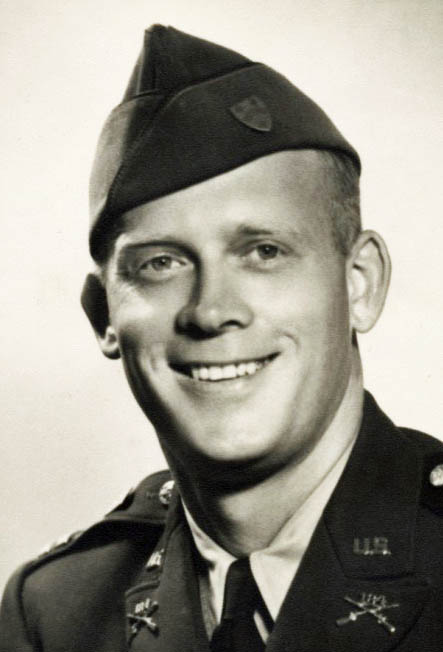
|
|
Officer with 140th Infantry Regiment Cross Rifles
Early 1940s
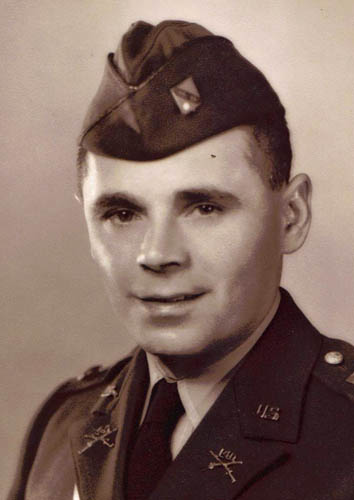
|
|
|
|
130th Infantry Regiment Officer's Insignia
marked Gemsco N.Y.

|
|
|
|
Enlisted Infantry Disk Supply Company Prewar to Early War Type
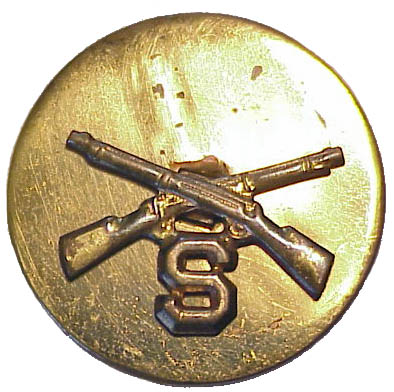
|
|
|
The Second World War ended in 1945 but the United States was left with the commitments of a world power, a series of regional conflicts and the cold war. Basic infantry branch insignia remained similar to those of the Second World War in design. Those dating since the middle 1960s often have an alphanumeric manufacturer's code stamped on the back. The types of clutches also assist in dating if they are original to the insignia. In 1952 enlisted members of the infantry branch were given the distinction of an additional blue (the infantry color) plastic frame accenting the collar disk. There were privately purchased domed collar disks worn by many enlisted soldiers during the post-World War Two period. In 1970 the Army returned to having two piece collar disks as regulation insignia, which were similar to the pre-World War Two ones except they were clutch backed rather than screw post. These had been available before 1970 as a private purchase item. Subdued insignia were first worn during the Vietnam conflict and exist in either cloth or metallic versions.
175th Infantry Officer's Insignia
In a group of post-World War Two Insignia

|
|
Modern Infantry Officer's Insignia
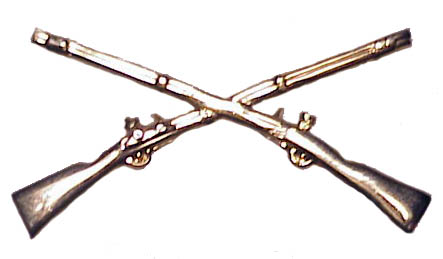
|
|
Back showing Manufacturer's Code S-21
for Harry Sugarman, Inc.
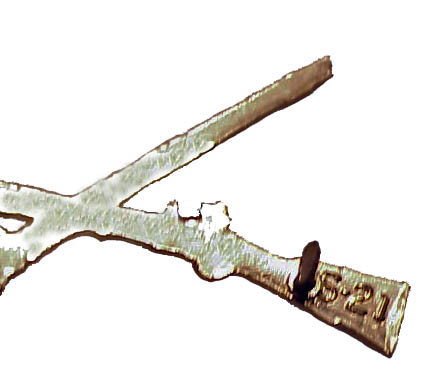
|
|
Post-World War Two Domed Disk with Infantry Blue Border

|
|
All images are either public domain or from the author's collection.
The various dates of use I list are my approximations and subject to error.
Evolution of U.S. Army Artillery Insignia
Evolution of U.S. Army Cavalry Insignia
Back to Insignia of World War Two
Back to Uniforms of the Civil War





